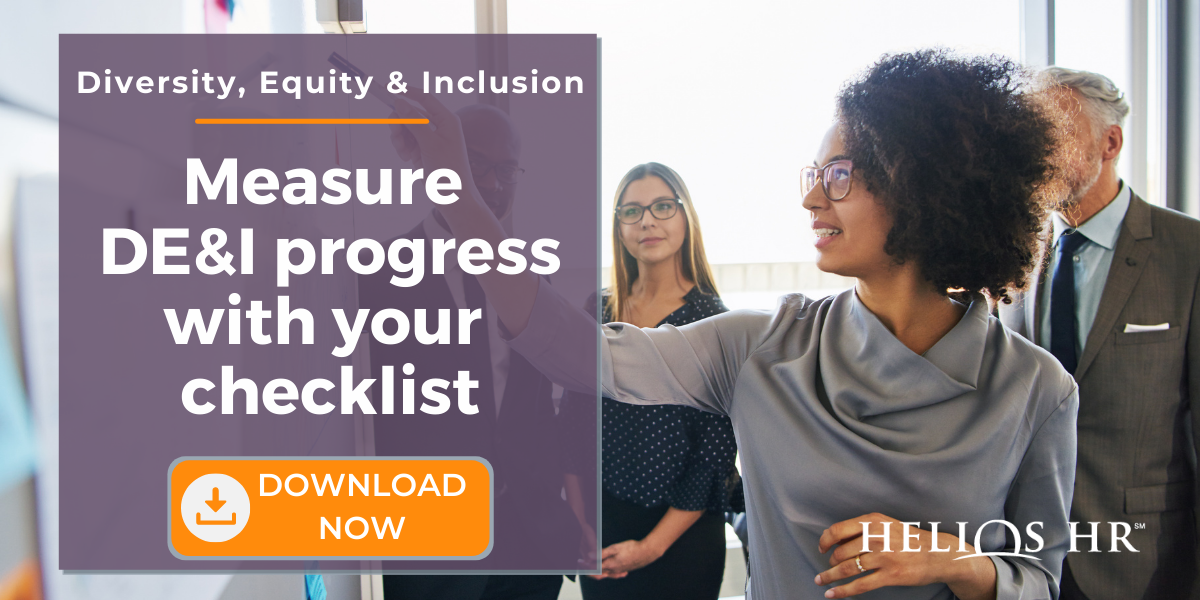By: Ber Leary on November 24th, 2021
What is DEI? Why Diversity, Equity and Inclusion Matters in HR
Most companies like to think of themselves as meritocracies, a place where anyone can get ahead if they work hard enough. But when we look at the current employment landscape, we see that this is not always the case.
The data tell a detailed story:
- There have only ever been 19 Black CEOS in the history of the Fortune 500
- Black women earn $0.63 for each dollar earned by white men
- 61% of employees have experienced workplace discrimination, with the most common triggers being gender, race, age, or sexual orientation
Another important statistic is this: 76% of job candidates look for companies that offer an inclusive work environment. In such a competitive job market, a strong DEI program could give you the edge that helps to attract great talent.
What is DEI in an HR context?
Diversity, Equity and Inclusion (DEI) is based on the understanding that there’s no single solution to help companies build a culture that welcomes everyone.
Instead, we have to acknowledge that discrimination is part of our broader social structure. To create the kind of team we want, we have to take a multi-pronged approach. This means tackling three main categories of challenges: diversity, equity, and inclusion.
What is diversity?
First of all, it’s important to note that the word diversity only applies to teams. A group of people can be diverse; a single person cannot.
Diverse groups include people from a wide range of backgrounds. Within such groups, you might find a diverse workforce with people of different gender, race, ethnicity, age, gender identity, sexual orientation, socioeconomic status, veteran status, and physical ability.
Diversity can be an organizational strength. When you have multiple perspectives, you can find innovative solutions to problems and even tap into previously unexplored markets. A study by McKinsey shows that this is a serious advantage, with diverse companies 35% more likely to outperform their more homogenous rivals.
What is equity?
Building a diverse team isn’t as easy as it might seem. You have to recognize the structural issues that can hold people back, issues that may be outside of your control. This the key difference between equity and equality.
For example, Ivy League schools accept legacy students (children of Ivy League graduates) at a rate of 33%, while the acceptance rate for non-legacy students is 6%. This creates a generational cycle, where a person’s career is largely defined by who their parents were. No employer is responsible for Ivy League school admission policies, of course. But you do have to think about the reality of access to college education when comparing candidates’ resumes.
Some issues arise out of circumstances. For instance, during the COVID-19 pandemic, women generally found themselves taking on extra personal commitments, such as childcare, homeschooling, and caring for unwell relatives. As a result, almost one in four women had to scale back their careers, compared to one in five men.
Equity is about understanding that different groups face different challenges. Declaring yourself to be an equal opportunities employer doesn’t necessarily mean that everyone has equal opportunity. You also have to look at individual circumstances and seek out a way to create a level playing field.
What is inclusion?
Diversity and equity focus on creating opportunities for people. But what happens after that? Will those people feel supported and welcome?
Unfortunately, many people don’t feel like they are a valued part of the team. Around 54% of Black workers say they feel a sense of belonging at work, compared to 70% of white workers. Meanwhile, 47% of women say they have faced gender discrimination at work.
But inclusion isn’t just about preventing harassment. It’s about ensuring that everybody feels supported and welcome when they work. That means giving people a chance to contribute at meetings, encouraging everyone to share ideas, and not excluding anyone from social events. If you have an inclusive culture, you’ll get the best out of all your employees.
How can HR help with DEI?
HR professionals play a vital role in their company’s DEI strategy. The HR team are the ones who have the tools to identify issues and implement solutions. Here’s how:
1. Analyze your current state
The first step is to gather information about your current DEI status. You can begin by examining demographic data for your employees. Do your teams show an acceptable level of diversity?
If so, then you can dig deeper and find out what employees think. Pulse surveys, engagement surveys, and focus groups will help you dig deep into employee sentiments.
2. Review your hiring process
DEI issues often stem from a flawed hiring process. There are some common problems to look out for, such as a lack of diversity in the hiring panel or inflexible education requirements. You may also find that you need to spread your net wider and advertise for candidates in new markets.
Remember to measure each step of your hiring process, from applications received to interviews arranged to final offers. This data will help to identify any DEI issues that might stand in the way of building a diverse team.
3. Build an employee consultation group
How do you assess your culture while also getting feedback on your processes and employee documents? Simple – just ask the team. Try bringing a group of employees together to share their experiences of diversity, equity, and inclusion.
If you organize such a group, then be sure to keep in touch and offer feedback on their suggestions. When people see that these consultation groups are leading to real change, they will understand that you’re genuinely committed to DEI.
4. Provide training and education where needed
Education is the best defense against discrimination. Many people on your team might not even realize that they’re doing anything wrong. Learning about things like unconscious bias and microaggressions can help open people’s eyes.
Your leadership team is often the ones who need the most training. They require the tools to resolve DEI issues and to practice inclusive leadership. Give managers a chance to learn directly from the HR team so that they can better understand the internal processes for dealing with complaints.
5. Bring in expert help
DEI can take a lot of effort and energy. It’s even more time-consuming when your HR team lacks the expertise to manage a large-scale DEI project. At that point, it’s cheaper and easier to bring in an experienced HR consultant to talk about your DEI strategy.
Need some expert help? Book a no-obligation consultation call with Helios HR today. We’ll be glad to talk about how you can build a diverse, equitable and inclusive culture that sets you up for long-term success.





